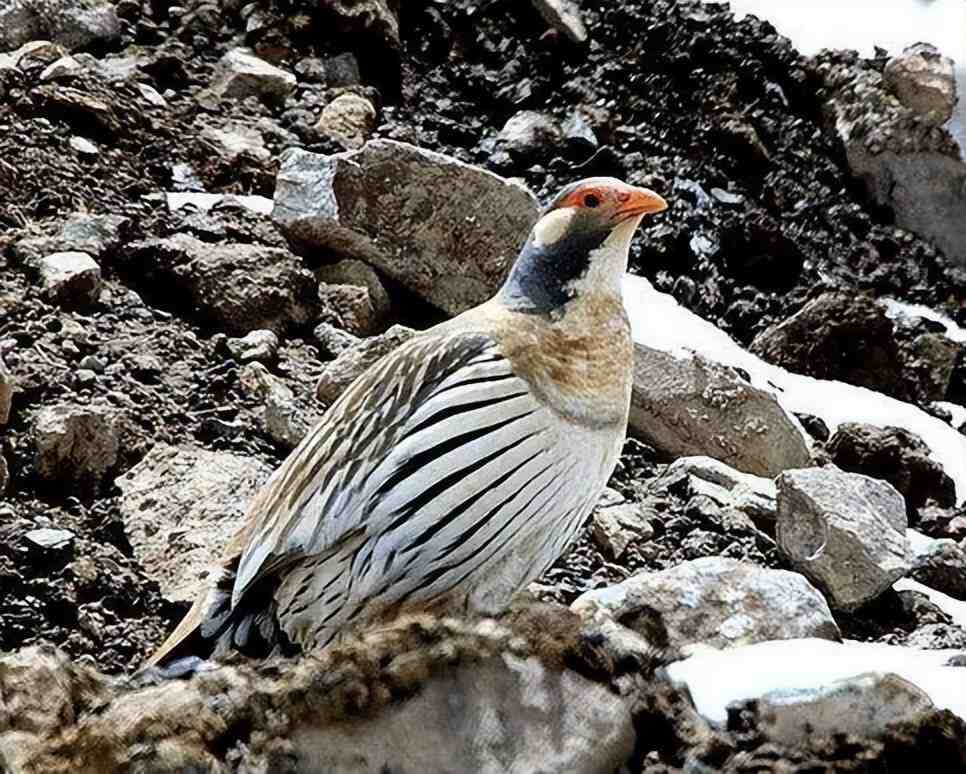Tetraogallus altaicus
IUCN
LCBasic Information
Scientific classification
- name:Tetraogallus altaicus
- Scientific Name:Himalayan Snowcock,Tetraogallus altaicus,Altai Snowcock
- Outline:Landfowl
- Family:Galliformes Phasianidae Snowcock
Vital signs
- length:58cm
- Weight:2.54-3kg
- lifetime:About 10 years
Feature
Known as the "climbing" expert in the pheasant family
Distribution and Habitat
Distributed in China, Kazakhstan, Mongolia and the Russian Federation (Russian Central Asia, Russian East Asia).
The Altai snowcock nominate subspecies is distributed in the Altai Mountains in the extreme north of Xinjiang, including Altay, Qinghe, and Fuyun counties; the northern Xinjiang subspecies of the Altai snowcock is distributed in the Beita Mountain area in the north of Mulei County adjacent to it.
The Altai snowcock inhabits high mountains and subalpine shrubs, tundra and bare rock areas between 2500-3000 meters above sea level. There is also a phenomenon of vertical migration, and it can descend to 2000 meters and the foot of the mountain in winter.
Appearance
The top of the head, cheeks, front of the eyes, back of the neck and upper back of the Altai Snow Chicken are gray, slightly decorated with brown, with sparse and fine inconspicuous spots, white spots on the eyes, and brown-gray ear feathers with silver. The shoulders and back have slate-gray horizontal bands, which gradually turn into dark gray feather edges on the back; the waist, upper wing coverts and tail are dark gray, with white stripes and light ochre feather edges; the waist, especially the upper wing coverts have large white spots on both vanes; the primary flight feathers are brown with black tips, and the base is more or less white; the secondary flight feathers are gray, lighter at the base; the outer vanes and tips have small brown ochre stripes. The chin and throat are gray with dark feather shafts; the upper chest is gray with a slight ochre brown, with more or less obvious white terminal spots and black secondary terminal spots; the chest and abdomen are white with nar
Details
Altai Snowcock, also known as Altai Snowcock, has two subspecies.

Altai Snowcock often moves in groups except during the breeding season. It likes to run on the ground, and often swings its tail feathers up and down while walking, which is its unique behavior. It runs fast on the ground, especially when in danger. It usually runs from the bottom of the mountain to the top of the mountain, never running down. Its wings are often used to help it climb up the slope. It moves very quickly and agilely. Even if it faces a vertical slope, it can quickly climb up. It usually takes off after reaching the top of the mountain. It also flies very fast, but the flying distance is not long, usually no more than 2-3 kilometers each time. It often makes loud calls when taking off. It frequently flaps its wings when flying. In addition to flapping its wings to fly, it often stretches its wings to glide. Especially when moving down the mountain, it often glides, never walking or running down. When it is active, it often makes soft calls as a signal for communication between individuals in the group. It also often makes high-pitched calls on the rocks and cliffs where it lives, especially in the early morning and evening.
Altai snow chickens mainly feed on buds, leaves, twigs, berries, fruits, catkins, seeds, tubers, and bulbs of alpine tundra plants. They also eat small invertebrates such as insects, and occasionally rodents. When foraging, they usually walk from the bottom of the mountain to the top of the mountain while foraging. After reaching the top of the mountain, they need to rest for a while, or comb their feathers, or take a sunbath, or rest under bushes and rocks to avoid the strong sunlight on the top of the mountain. After resting, they glide down to the mountainside, and then forage for food from the bottom to the top for the second time until dark.
The call of the Altai snow chicken is harsh, shortened from the semi-whistle geuk-geuk-geuk to guk-guk-guk and ending with the transposition of rrruuuuuu.
The breeding season of Altai snow chicken is from April to June. They start to estrus and courtship in March. After mating, they leave the group and occupy the nesting area to build nests. They usually build nests in the alpine rock tundra area. The nests are mostly placed in the ground pits or rock crevices under the shelter of protruding rocks. The nests are mainly built by female birds. The structure of the nest is relatively simple, mostly composed of wild plants and a small amount of feathers, and some nests located in gravel or gravel are mainly composed of feathers. After the nest is built, eggs will be laid. Each nest lays 4-8 eggs, up to 15 eggs. The color of the eggs is light yellow to gray-green, with dark brown spots of varying sizes. Incubation begins when the last 1-2 eggs are laid. The incubation is undertaken by the female bird. The size of the eggs is 67-70×43-47 mm, and the egg weight is 50-58 grams. The incubation period is 28 days.
Only about 50 Altai snow chickens have been found in China, making it the rarest species of snow chicken in China.
Although the distribution range of the Altai snow chicken is small, there is still a certain number on the Mongolian side, with a density of 0.15-0.30 per hectare, which is not close to the critical value of vulnerable and endangered species survival (distribution area or fluctuation range is less than 20,000 square kilometers, habitat quality, population size, and distribution area fragmentation). The population trend is stable, so it is evaluated as a species with no survival crisis.
Listed in the "Red List of Endangered Species of the World Conservation Union" (IUCN) 2016 ver 3.1-Least Concern (LC).
Listed in China's "National Key Protected Wildlife List" (February 5, 2021) Level 2.
Protect wildlife and eliminate game.
Maintaining ecological balance is everyone's responsibility!








